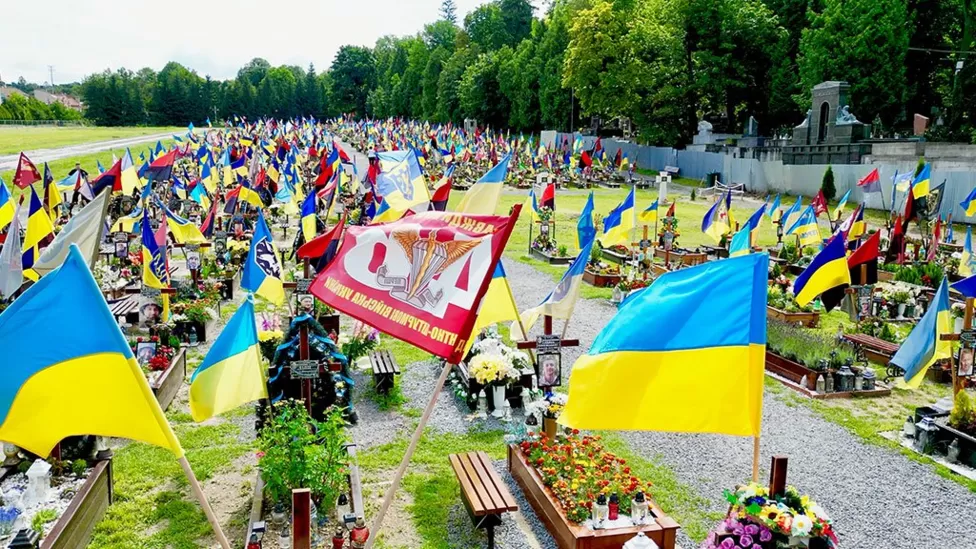Dying by the dozens every day Ukraine losses climb

She speaks to the dead in a small brick mortuary near the front line in Donetsk, where thousands of unknown soldiers lie piled high.
I wish to apologize for their deaths. It’s as if they can hear, but they can’t respond. I want to thank them somehow.”
Outside the mortuary’s heavy door, she sits at her cluttered desk, pen in hand. Her job is to record the details of the deceased.
The Ukrainian armed forces have reiterated that their war casualty numbers are a state secret, but Margo knows the losses are high.
It is unclear what the figures are. According to the New York Times, US officials estimate that 70,000 people have died and 120,000 have been injured in the attack. Considering that there are only half a million soldiers in the armed forces, that is a staggering number. To date, 9,177 civilian deaths have been recorded by the UN.
Margo’s inside right arm has a small tattoo of a mother and child, along with the birthdate of her son. Ukrainian colours are painted on her manicured nails. The front of her black T-shirt reads “I’M UKRAINIAN.”.
She says the hardest part is seeing a dead young man who hasn’t even reached 20, 22 years old. “And realizing they didn’t die their own death.”. “They were killed for their own land. The most painful part is that you can’t get used to this. Now it’s just about helping the boys get home.”.
The day her common-law husband died was the most difficult day of her life, she says. On 29 December 2022, Andre, 23, was killed in battle.
She says he died defending his motherland. “But then, for the umpteenth time, I have convinced myself I should be here, helping the fallen.” She says the job has made her hard as steel. She says she never cries in public even when she sees the bodies being brought into the mortuary.
The tears I shed are kept inside me until I get home in the evening. No one sees them.”
According to leaked Pentagon estimates from April, Ukrainian deaths were much lower at 17,500. In part, the counter-offensive in the south can explain the alleged jump to more than 70,000. One brigade commander who is fighting there told me it was “worse than Bakhmut” in its early days. In one of the bloodiest battles of the war, Donestsk fell to Russia in May.
Ukraine has changed tactics there, but the initial push to breach Russia’s occupation defences in June was costly, especially for young, newly trained soldiers. The Donetsk village of Velyka Novosilka was losing dozens of soldiers every day, one senior sergeant told me in June.
The mortuary, one of many along the front line, works to identify unknown soldiers.
The body bags are brought outside, one at a time, and the search for clues begins. There is a corpse inside the first body bag, his eyes still open, his hands folded carefully across his lap. He has a gash on the side of his leg and a cut on his face. The right hand of another body is missing fingers, and blood and battlefield mud stain his uniform.
Mortuary staff cut open their pockets, still containing the artefacts of everyday life – keys, mobile phones, wallets with family photos. As a result of their death, these items may now serve as clues that could lead to the identification of the unidentified.
On another body bag, the word “Unidentified” has been scored out and replaced with the name and company details of a man.
I am unable to say how many body bags have emerged due to reporting restrictions.
A group of soldiers – commanders of various ranks – arrive in an army pick-up truck and smoke cigarettes outside the mortuary. One body is inspected to determine if it belongs to their platoon, company, or battalion. He appears to have been killed in an artillery strike – his head is missing and his body is badly wounded, even worse when he’s turned over.
“It’s hard. Unpleasant. But it’s part of our job. We have to give the boys a proper send-off,” explains “Avocat,” a deputy battalion commander.
The body will be identified by more members of his unit, he says.
Ukraine’s cemeteries reveal the extent of casualties.
Around Krasnopilske cemetery in Dnipro, the heads of the sunflowers hang heavy – an honour guard for the freshly dug graves that are spreading closer and closer to the perimeter.
Oksana, 31, weeps alone at one such graveside. She looks down at pictures of her dead husband Pavlo. He was a power-lifting champion and a personal trainer. A missile from a Russian helicopter struck his convoy near the city of Izium during Ukraine’s previous counter-offensive in November.
